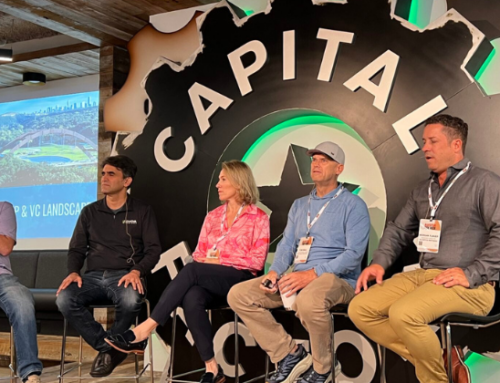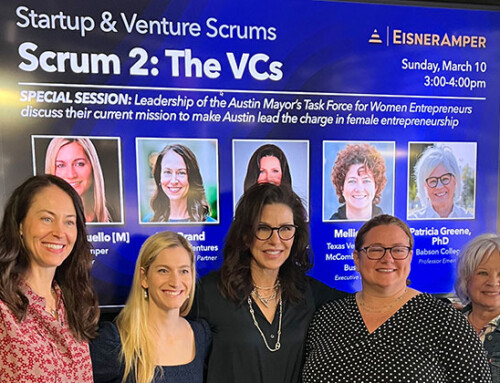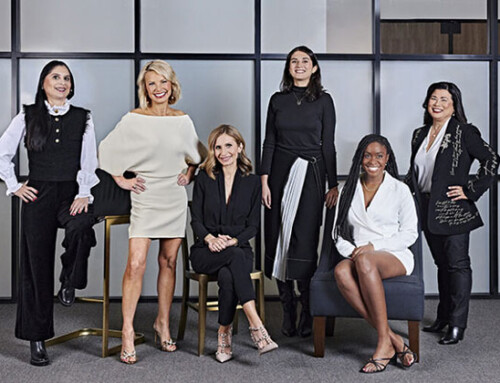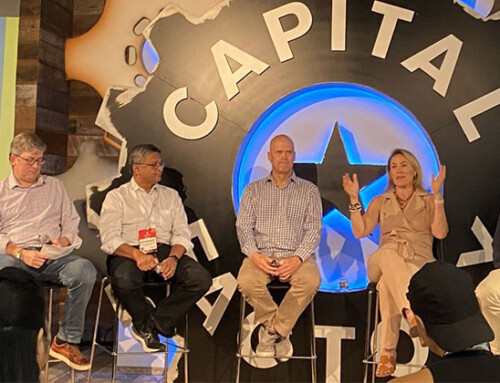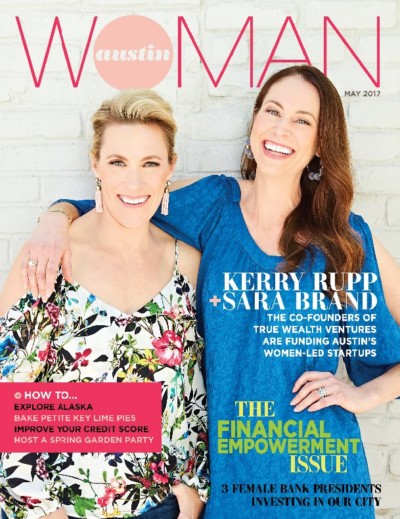
This article originally appeared here.
Kerry Rupp and Sara Brand, the passionate leading ladies and power duo behind venture-capital firm True Wealth Ventures, discuss why investing in women is a smart business move and why supporting female innovation is their career calling.

By Sarah E. Ashlock , Photos by Annie Ray, Hair and makeup by Laura Martinez, Styled by Ashley Hargrove
I first chatted with venture capitalists Sara Brand and Kerry Rupp on a blistering summer day not quite a year ago. They had recently filed with the U.S. Securities and Exchange Commission to launch their venture-capital firm, True Wealth Ventures, and were celebrating their first close on investments that landed the firm $4.7 million.
Less than a year later, True Wealth Ventures is still geared for greatness. The firm had an additional close, and Brand and Rupp have the rest of this year to meet their fundraising goal of $20 million. This amount, the duo explains, will be invested during the course of four years into startups and companies that have at least one woman on the executive team making decisions.
On a recent March afternoon, a spring day that had yet to signal the oppressively hot summer ahead, Brand, Rupp and I settled in at Caffe Medici on South Lamar Boulevard, savoring our caffeine of choice beneath ambient pendant lighting.
“I’ve already had my fair share of coffee today,” Rupp is quick to confess.
During the course of the next hour or so, the ambitious duo effortlessly explains the intricacies of what it is they do, why it is they do it and how much they love their jobs. Though the theme of the conversation is inherently serious, every few minutes of discussion is interspersed with laughter, and it’s suddenly all too easy to understand why they love what they do.
 Observe and Question
Observe and Question
How the heck do two women with science backgrounds become venture-capital boss ladies in the first place? What came into focus during our conversation is that in order to discover the career you’re passionate about, you have to first uncover what you want your job to look like. This means honing in on the qualities and characteristics you most enjoy rather than focusing only on the position itself.
Before Brand partnered with Rupp, she worked at worldwide consulting firm McKinsey & Company. She read a book written by the firm’s senior director, Joanna Barsh, called Centered Leadership, which urged Brand to explore questions like, “Think back to your childhood. When were you in flow? When did you not realize time was going by? What kind of activities did you do?” Part of this process, Brand explains, requires the reader to jog her memory or gain insight by asking those closest to her what they remember.
“I was trying to figure out what I wanted to do exactly and realized when I was young, I would read lots of sci-fi books and books about how planes were made,” Brand says. “You knew exactly what you wanted to do in 8th grade. You were going to go into mechanical engineering, would give speeches about how fighter planes worked.”
Brand would later decide to pursue a career in that field, but when she peeled away the layers of her underlying interests, she recognized what she was most passionate about was simply learning new things. After all, she didn’t have a poster of Albert Einstein on her wall as a kid for no reason.
“I loved to learn about new technologies and have conversations about it,” Brand says. “I realized that is what I actually love to do. I climbed so far up the corporate ladder, where the air was so thin, but it was in management, not in technical stuff anymore.”
Her affinity to grow, to evolve is evident in her thoughtful and clear-eyed approach to her work.

“Being in venture capital is such a great mix for me because it’s still hands-on, making an impact, making successful businesses, but I love learning about technologies,” she says.
Rupp has her own similar insights.
“I am a really high P on the Myers-Briggs scale, which means I like things to stay in flux,” Rupp says.
Brand interrupts to say, “That’s perfect for you!”
The two laugh and Rupp continues.
“In college, I didn’t pick my major until my senior year. They make you pick one, so I kept fake picking one. I was English, I was psychology, I was foreign language. I’d just change it every once in a while. I ended up majoring in science, which meant I had to take, like, eight science classes my senior year,” Rupp says. “All my friends were done second semester, sitting on the quad in the sun, and I’m in the lab doing genetic experiments.”
Like Brand, Rupp finds her energized feeling when she “gets exposed to lots and lots of different things.” After she moved 24 times, visited 55 countries and 49 states, Rupp’s adventurous spirit now serves as one of her greatest career strengths.
“While this juggling-plates thing is really challenging, it’s also the only way I know how to be,” Rupp confides.
When Rupp left her corporate job and was reassessing her next career move, she conducted meetings with people in coffee shops.
“I wasn’t looking for a job. I took some time off. I was just meeting people,” Rupp explains of the transition. “I’d sit down with [people], work on their strategy, who to introduce them to, and I thought, ‘This is so fun! I wish this could be my job.’ ”
Indeed, Rupp would end up making that her job. She has been in the startup world for two decades now and is the former CEO and general partner of Dreamit, where she helped launch more than 150 early stage companies.
“It’s not like I was sitting in those coffee meetings thinking, ‘I should be a VC,” she says, “but through the course of time, as I took the accelerator role and saw what I was doing every day, I thought, ‘How funny. A few years ago, I wanted this to be my job, didn’t know it existed and now it actually is.’ ”
 Research and Review
Research and Review
Once Brand and Rupp identified the components that ignited their spark, they joined forces to advocate for the economic advancement of women-led businesses.
“There’s substantive data that shows that if there’s more gender diversity in teams across the board, not just in business, those teams perform better,” Rupp says. “In this case, in early stage companies, they actually have better performance.”
Brand mentions that Kevin O’Leary, one of the “sharks” on investment-based reality show Shark Tank, told the press this very thing. Of the companies he’s invested in, more than half have female CEOs, and there hasn’t been one male-led business to outperform those women-led businesses. That sentiment makes a strong case for considering investing in companies that have women in top decision-making seats.
A lot of operational and legal setup was required to make True Wealth Ventures a reality, but Brand and Rupp aren’t accustomed to shying away from the tough stuff, the nitty-gritty details of business.
So, what does a day in the life of a venture capitalist look like? The only routine in Brand and Rupp’s workday is that there isn’t one.
“About 75 percent of a workday is either in a meeting or on a call,” Rupp says.
For venture capitalists, the clock is always ticking. Brand mentions they have increased their normal 20-minute meeting time to 30 minutes so they have time to fully engage with entrepreneurs. This 10-minute addition is just one example of how Brand and Rupp conduct their work, always evolving their balanced approach with both efficiency and intention so as to make wise, thoughtful investments.
In order to prepare for said meetings and evaluate follow-up questions and potential investments, Brand and Rupp must, of course, first learn about the startup. It’s also crucial to have knowledge of that company’s particular industry, so their questions are more pointed and dynamic.
 The first step for a startup seeking funding is to provide a pitch deck, which often includes information on a problem, solution, business model, sales and so on. Much can be understood by simply reading a pitch deck, but for True Wealth Ventures, it’s crucial that Brand and Rupp listen to the entrepreneur. The company leader should be able to verbalize its intentions with ease and confidence.
The first step for a startup seeking funding is to provide a pitch deck, which often includes information on a problem, solution, business model, sales and so on. Much can be understood by simply reading a pitch deck, but for True Wealth Ventures, it’s crucial that Brand and Rupp listen to the entrepreneur. The company leader should be able to verbalize its intentions with ease and confidence.
“We get that benefit of hearing how the entrepreneur presents it, which really changes the dynamic when so much of this is about the team behind the company, letting them have their voice tell the story rather than the deck that a designer probably did for them,” Rupp says.
When True Wealth Ventures is ready to move forward with an investment, Rupp says the time spent analyzing a company’s industry and data “is almost infinite.” It might be easy to dismiss the research side of this job, but it’s one of those things that, if disregarded, causes more arduous work later on.
 “There’s some data for [angel investors] showing that angel portfolios have better returns when they do up to 40 hours of due diligence,” Brand says.
“There’s some data for [angel investors] showing that angel portfolios have better returns when they do up to 40 hours of due diligence,” Brand says.
Those 40 hours tie back to what Brand and Rupp love so much about this industry: learning new things, multitasking and simply figuring stuff out.
While angel investors use their own funds to invest in startups and companies, venture capitalists fundraise for money to invest in companies.
“Since we’re using other people’s money, [time spent researching a company] would probably be more,” Brand says.
The duo must choose their investments wisely, and can only do so once they’ve gathered as much knowledge as possible. While angel investors can go with their gut feelings, venture capitalists have a fiduciary responsibility to read every word and conduct thorough research.
Being the savvy women they are, Brand and Rupp work with interns from the University of Texas’ Venture Fellows Program. These MBA students assist in organizing and navigating True Wealth Ventures’ varied schedules while gaining vital venture-capital experience.
“It’s a hard industry to get into, so having experience can make a big difference,” Rupp says.
“It’s pretty exclusive too,” Brand adds. “It’s hard to get into the program.”
As venture capitalists, both women are natural educators who patiently and eagerly explain complex terms and situations related to their industry.
With the interns’ assistance, Brand and Rupp have the opportunity to reach a bigger audience and devote time to hearing pitches, researching companies and fundraising. They have more capabilities to cast a wider net in the sea of female business leaders in Austin.
“In the past three weeks, we’ve probably been talking to 20-plus companies, two of which we’re going into real due diligence with,” Rupp says.
Using the $20 million they are currently raising, True Wealth Ventures will likely invest in about 12 companies. Once they’ve completed this fund, they will continue to fundraise for the same amount, if not more, in three to four years to help continue the investment cycle.
Their initial $20 million fundraising goal was a number chosen intentionally. In the world of venture capital, that amount of funds is considered—on the spectrum of VC dollars—on the smaller scale. But that figure, Brand and Rupp say, was selected on purpose.
“There is data showing that smaller funds do better,” Brand says.
Larger venture-capital firms with $200 million in capital may have a big reputation, but they have to fund big companies to match. Plus, True Wealth Ventures’ relatively small size enables Brand and Rupp to invest where other VC firms cannot: in a company’s seed stage of growth.
Brand and Rupp meticulously came up with that amount partly because of federal regulations.
“The SEC has limitations of how many investors can invest in a fund, and it’s 99 individuals,” Brand says. “So, you can’t just take a $10,000 check. If we had a $50 million fund, everybody would have to be writing almost a million-dollar check. That really narrows your market.”
There’s also an added personal touch when working with a small venture-capital firm. Think of it like this: Would you rather have your next meeting catered by Tacodeli or Taco Bell? Entrepreneurs obtaining funding from Brand and Rupp may find their voices are heard more and that, on the flip side, investors feel more confident and comfortable in contributing funds to True Wealth Ventures.
In order to obtain funds to invest in companies, Brand and Rupp have to, of course, obtain investments themselves.
“We’re both fundraising and seeking deals right now,” Rupp says. “It’s interesting because it puts us in the shoes of the entrepreneur.”
That means a whole heck of a lot of meeting with investors where they are and sitting in coffee shops with startup entrepreneurs seeking investors. When they’re not taking calls in their cars, they’re actively working in their homes—literally. Both Brand and Rupp are now the proud owners of treadmill desks.
Once one invests in True Wealth Ventures or True Wealth Ventures invests in a company, they’re immediately ushered into a unique community.
“Twice a year, we’re having these events where we have our investors and the leaders from our portfolio companies get together. A lot of our investors want to help the companies when and where they can,” Brand says. “That will make those kind of serendipitous relationships happen.”
Investors also receive quarterly updates on how the companies are doing.
While Austin continues to burst at the seams with incredible growth, True Wealth Ventures’ approach to funding these up-and-coming female-led businesses captures what made Austin so great in the first place, that sense of unparalleled connection and community.

Protect Your Force Field
It’s no secret shots are often fired at women stepping into new terrain. For female investors and entrepreneurs alike, it’s imperative to not only identify and vocalize their points of view, but to protect them as well. Brand and Rupp wouldn’t be where they are today without their resolve to be forward-thinking and stay true to their mission.
A little out-of-the-box thinking is often necessary, and Brand and Rupp have embodied that sentiment. True Wealth Ventures recently won a $250,000 grant from the U.S. Economic Development Administration, in conjunction with Dell Medical School, the criteria of which centered on regional economic development in order to support areas that are underfunded.
But Brand and Rupp took a different approach in their grant application since the grant was originally intended for geographical regions.
“We applied with the premise [that] women were the region that are under-funded, and apparently, we got extra credit for the fact that women as investors are also underfunded,” Rupp says.
Clearly, having the insight to make this distinctive approach proved effective.
As venture capitalists, Brand and Rupp serve as catalysts for these companies, which expands the breadth of their reach. Without a woman, or in this case, women, financially supporting women-led companies, the opportunity to flounder is even higher. And industry needs women-led businesses.
“Ninety-six percent of venture-capital partners are men, and if you look at who is really making investment decisions, it’s probably more like 99 percent,” Rupp says.
Brand and Rupp have chosen to invest primarily in consumer-health markets and sustainable consumer markets, in which women are the predominant consumers.
“It’s not just about the gender, but to leverage that gender strategically to focus on markets where women are the primary customers,” Rupp says.
The sustainable consumer market is an avenue that interests Brand and Rupp. In the home, this ranges from eco-efficient appliances to beauty products and food. What interests Brand and Rupp about this area aren’t simply the products, but the supply chains behind the products. An example concept involves packaging food in a more sustainable way. This can be subtle, and maybe the consumer doesn’t realize there’s a technology company behind a product that is manufacturing the packaging in a more eco-friendly way.
“We aren’t just [investing in] a cool new veggie burger,” Rupp says. “We could, but we could also do clothing with recycled fabric that came from a materials science innovation.”
On the health side, Brand and Rupp adhere to the concept of “health care versus sick care,” with the aim to invest in companies that target wellness and prevention. The key consideration is that consumers are the ones deciding, which means the companies aren’t selling their items to doctors, who then prescribe the products to patients. Rather, the consumer chooses the product or service.
An example of this approach can be found in Rupp and Brand’s first investment: UnaliWear. Jean Anne Booth’s company was a winner of the 2016 Woman’s Way Women-Led Business of the Year award for her Kanega smartwatch. The wearable concept is a more approachable and aesthetically pleasing life-alert device used to empower senior citizens and those with limited mobility by acting as an emergency device and a medications reminder.
Of course, women’s health is a particularly interesting component of this field.
“There’s been such little innovation because of who’s at the leadership table in corporate companies and who’s been investing,” Brand says.
Spoiler alert: It’s mostly been men.
And as Rupp explains, “[Men] don’t necessarily understand things like menstruation and fertility. This is exciting news for women because it means more options and better products are actually being considered by investors.”
“Women keep things on track [in the home],” Rupp expounds.
“But [they go] unpaid and unrecognized a lot,” Brand adds.
Like a scientific experiment, entrepreneurs often start with observation, questions, research, a hypothesis, collected data and an aptitude to take on variables. What can happen as a result of an experiment that goes right? Innovation.
There are a lot of Texas women with groundbreaking, pivotal, ingenious ideas who haven’t been given more than a passing glance of consideration, those whose innovations have yet to be given the time of day. That is, until now.
Women in Business
In a parallel universe, these statistics wouldn’t exist, but thanks to Sara Brand and Kerry Rupp, things are looking brighter.
#2: Texas ranks second in the U.S. for fastest growth in the number of women-owned businesses.
(Source: American Express)
85 percent of consumer-purchase decisions are made by women.
80 percent of health-care decisions are made by women.
(Source: Marketing Zeus, U.S. Department of Labor, Center for Talent Innovation)
32.1 Percent of Women-led startups have a 32.1 percent greater chance of an exit (or making a profit) when funded by women VCs.
(Source: Harvard Business Review)
35 percent of total funding on Kickstarter goes to companies with a woman CEO.
#1: San Antonio is ranked No. 1 for women entrepreneurs out of 100 U.S. Metropolitan cities.
2 times: That’s the growth rate of women starting businesses, compared with men.
#2: That’s Texas’ national ranking for fastest growth in the state’s number of women-owned businesses.
(Source: Kauffman Foundation, Ventureneer, American Express)
According to First Round Capital, based on 10 years of seed-stage VC funding, companies with a female founder performed 63 percent better than investments with all-male founding teams.
#3: Dallas is the third-best city in the country for women entrepreneurs.
(Source: Center for an Urban Future)
#1: Austin is the No. 1 city in the U.S. for startup activity.
(Source: Kauffman Foundation)
1,200: Women start about 1,200 new businesses every day.
(Source: Open State of Women-Owned Business)


